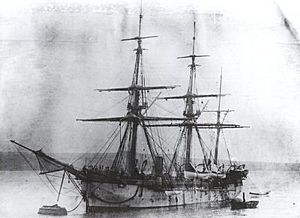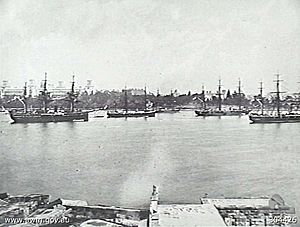HMS Egeria (1873) facts for kids

HMS Egeria
|
|
Quick facts for kids History |
|
|---|---|
| Name | HMS Egeria |
| Builder | Pembroke Royal Dockyard |
| Cost | Hull £32,468, machinery £10,414 |
| Laid down | 30 December 1872 |
| Launched | 1 November 1873 |
| Completed | November 1874 |
| Reclassified | As survey ship, October 1886 |
| Fate | Sold, October 1911 |
| General characteristics | |
| Class and type | Fantome-class sloop |
| Displacement | 949 long tons (964 t) |
| Tons burthen | 727 bm |
| Length | 160 ft (48.8 m) (p/p) |
| Beam | 31 ft 4 in (9.6 m) |
| Draught | 14 ft (4.3 m) |
| Depth | 15 ft 6 in (4.7 m) |
| Installed power | 1,011 ihp (754 kW) |
| Propulsion |
|
| Sail plan | Barque rig |
| Speed | 11 knots (20 km/h; 13 mph) |
| Range | 1,000 nmi (1,900 km; 1,200 mi) at 10 knots (19 km/h; 12 mph) |
| Complement | 125 |
| Armament |
|
HMS Egeria was a special type of sloop (a small warship) with four guns. It was launched in 1873 at Pembroke Dock in Wales. The ship was named after Egeria, a water nymph from Roman mythology. Egeria was the second ship in the Royal Navy to have this name. It had a busy career sailing in the East Indies, Pacific Ocean, Australia, and Canada. The ship was eventually sold and taken apart in 1914. Its final end was being burned in British Columbia.
Contents
Building the Egeria
Egeria was built using an iron frame covered with teak wood and copper. This made it a "composite" ship. It was powered by a two-cylinder steam engine. This engine turned a single propeller, which was about 11 feet (3.4 meters) wide. It produced about 1,011 horsepower. Three round boilers created the steam needed to run the engine.
Egeria in the Perak War
In 1875, Egeria sailed to Perak, which is now part of Malaysia. It joined a group of six ships. Their mission was to help in an expedition against those involved in the death of Mr. James W. W. Birch. He was a British official in Perak.
While soldiers and a special naval team moved up the Perak River, Egeria helped by blocking the coast. Its smaller boats went up the Kurow River. These boats found and took away guns and ammunition that could have been used by the enemy. This action helped the British forces.
Gathering Information in Russia
During the Russo-Turkish War (1877–1878), Egeria was sent on a secret mission. It went to Petropavlovsk-Kamchatsky in Kamchatka, Russia. The goal was to gather information. When the ship arrived, the Russian military had already left the area.
Mapping the Coast of Australia
From 1886, Egeria was used for important survey work around Australia. A survey ship maps coastlines and waters to create accurate charts for other ships.
In 1887, the ship visited Christmas Island.
In 1890, some sailors on the Egeria faced serious consequences. They were found to have disobeyed orders. Some sailors were given long sentences for not following rules and trying to cause trouble. Other sailors also received punishments for disobedience.
Mapping British Columbia
In 1898, Egeria arrived in British Columbia, Canada. It continued its important work of surveying the coast for the Royal Navy. This work lasted until 1910. After that, the Canadian Hydrographic Service took over the responsibility for coastal surveys.
Egeria mainly re-surveyed areas that were already settled. This helped create new, more detailed maps. The last survey it did was of Welcome Pass, off the Sunshine Coast of British Columbia.
You can see a picture of Egeria on a special tile at the Marine Building in Vancouver. This building, opened in 1930, honors eight historic ships of British Columbia.
There is also a carving on a rock cliff near Poets Cove on Pender Island, British Columbia. It says "1905 HMSEGERIA". This shows where the ship's crew might have been.
A dining hall at HMCS Quadra, a Canadian Forces Base in Comox, is named Egeria Hall. It was built in 1995 to honor HMS Egeria.
End of Service and Sale
After many years of surveying, Egeria was put up for sale in November 1911. It was sold at an auction in Esquimalt to the Navy League for £1,416.
What Happened to Egeria?
The ship was sold to be broken up in 1914. Its empty hull was pulled ashore at Burrard Inlet. It was then soaked in oil and set on fire. Sadly, this explosion caused the deaths of three men.
Egeria's Legacy
HMS Egeria is remembered in the scientific name of a type of lizard. This lizard is called Cryptoblepharus egeriae.



